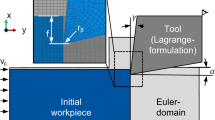Abstract
In this paper, the machining process to produce the right surface profile in machining low-rigidity parts is studied by considering moving dynamic cutting forces that statically and dynamically excite the tool and part reducing the validity of these packages’ output and leading to additional surface errors. The proposed approach is based on producing a simulation environment integrating a data model, an analytical force prediction model, a material removal model and an FE analysis commercial software package. This reported result focuses on the development of the simulation environment and the data model. The integrated environment provides a platform by which FE analysis commercial packages, ABAQUS, can exchange data with the proposed data model, force model and material removal model, to deliver new functionality for machining process simulation where there is force-induced part deflection. The data model includes complete mesh and analysis information for predicting part deflection and enables iterative data updating for multi-step simulation. The proposed simulation methodology has been experimentally validated.
Similar content being viewed by others
References
Liu S, Soldatos KP (2002) On the improvement of transverse stress distributions in cross-ply laminated beams: advanced versus conventional beam theories. Int J Mech Sci 44:287–304
Herranz1 S, Campa FJ, Lo’pez de Lacalle LN, Rivero1 A, Lamikiz A, Ukar1 E, Sa’nchez JA, Bravo U (2005) The milling of airframe components with low rigidity: a general approach to avoid static and dynamic problems. Proc I MECH E Part B J Eng Manuf 219(B11):789–802
Tsai J, Liao C (1999) Finite-element modelling of static surface errors in the peripheral milling of thin-walled workpiece. J Mater Process Technol 94:235–246
Ratchev S, Nikov S, Moualek I (2002) Material removal simulation of peripheral milling of thin wall low-rigidity structure using FEA. Proceedings of the 35th CIRP international seminar on manufacturing systems, Seoul, Korea, 13–15 May pp 371–377
Ratchev S, Liu S, Huang W, Becker AA (2004) Milling error prediction and compensation in machining of low-rigidity parts. Int J Mach Tools Manuf 44:1629–1641
Ratchev S, Huang W, Liu S, Becker AA (2004) Modelling and simulation environment for machining of low-rigidity components. J Mater Process Technol 153–154:67–73
Ratchev S, Liu S, Huang W, Becker AA (2006) An advanced FEA based force induced error compensation strategy in milling. Int J Mach Tools Manuf 46:542–551
Suneel TS, Pande SS (2000) Intelligent tool path correction for improving profile accuracy in CNC turning. Int J Prod Res 38(14):3181–3202
Mackerle J (1999) Finite-element analysis and simulation of machining: a bibliography (1976–1996). J Mater Process Technol 86:17–44
Spence AD, Abrari F, Elbestawi MA (2000). Integrated solid modeller based solutions for machining. Comput Aided Des 32:553–568
Tsai J, Liao C (1999) Finite-element modelling of static surface errors in the peripheral milling of thin-walled workpiece. J Mater Process Technol 94:235–246
Marusich TD, Ortiz M (1995) Modelling and simulation of high speed machining. Int J Numer Methods in Eng 38:3675–3694
ABAQUS 6.3. ABAQUS Inc, 1080 Main Street, Pawtucket, Rhode Island, 02860–4847, USA. http://www.abaqus.com
Cho MS, Sim KS, Suk HC, Chang SK (2000) Static strength analysis of CANDU-6 reactor fuel bundle. Nucl Eng Des 200:407–419
Zha Y, Moan T (2001) Ultimate strength of stiffened aluminium panels with predominantly torsional failure modes. Thin-Walled Struct 39:631–648
Choi BK, Jerard RB (1998) Sculptured surface machining: theory and applications. Kluwer Academic, Dordrecht
Sagherian R, Elbestawi M (1990) A simulation system for improving machining accuracy in milling. Comput Ind 14:293–305
Jang D, Kim K, Jung J (2000) Voxel-based virtual multi-axis machining. Int J Adv Manuf Technol 16:709–713
Ratchev S, Nikov S, Moualek I (2002) Material removal simulation of peripheral milling of thin wall low-rigidity structure using FEA. Proceedings of the 35th CIRP international seminar on manufacturing systems, Seoul, Korea, 13–15 May pp 371–377
Kline WA, DeVor RE, Shareef IA (1982) The prediction of surface accuracy in end milling. J Eng Ind 104:272–278
Sutherland JW, DeVor RE (1986) An improved method for cutting force and surface error prediction in flexible end milling systems. J Eng Ind (Transaction of the ASME) 108:269–279
Budak E, Altintas Y (1995) Modelling and avoidance of static form errors in peripheral milling of plates. Int J Mach Tools Manuf 35(3):476–495
Feng HY, Menq C (1994) Prediction of cutting forces in the ball-end milling process-I: model formulation and model building procedure. Int J Mach Tools Manuf 34(5):697–710
Merchant ME (1944) Basic mechanics of the metal citing process. ASME J Appl Mech A-168–175
Budak E, Altinrtas Y, Armarego EJA (1996) Prediction of milling force coefficients from orthogonal cutting data. ASME J Eng Ind 118:216–224
Altintas Y (2000) Manufacturing automation. Cambridge University Press
Author information
Authors and Affiliations
Corresponding author
Rights and permissions
About this article
Cite this article
Ratchev, S., Liu, S., Huang, W. et al. Machining simulation and system integration combining FE analysis and cutting mechanics modelling. Int J Adv Manuf Technol 35, 55–65 (2007). https://doi.org/10.1007/s00170-006-0700-6
Received:
Accepted:
Published:
Issue Date:
DOI: https://doi.org/10.1007/s00170-006-0700-6




